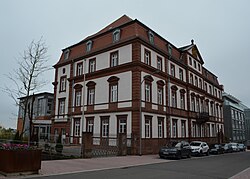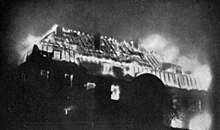District Office Pirmasens (building)
| District Office Pirmasens | ||
|---|---|---|
 The district office building in Pirmasens |
||
| Data | ||
| place | Pirmasens | |
| architect | Ludwig von Stempel | |
| Client | District Office Pirmasens | |
| Architectural style | Baroque mansard roof building | |
| Construction year | 1882-1883 | |
| Coordinates | 49 ° 12 '6 " N , 7 ° 36' 8" E | |
|
|
||
The former Royal Bavarian District Office is a listed Wilhelminian-style building in Pirmasens , which today houses the administration of the Pirmasens-Land Association . It became famous as the scene of the bloody end of the separatist movement in the Palatinate in 1924.
location
The old district office is located at Bahnhofstrasse 19 on the edge of the city center. It is located between the headquarters of the Sparkasse Südwestpfalz and the former Ludwig Kopp shoe factory, opposite is the administrative complex of the Pirmasens district court .
history
Establishment
The building was erected in 1882/1883 by the Grünstadt architect Ludwig von Stempel , who at that time was working as an assessor at the Landbauamt Kaiserslautern. Stempel also built the district court building diagonally opposite and the city's main post office from the Wilhelminian era on Bahnhofstrasse in Pirmasenser . The purpose of the building was as the administrative seat of the district office of Pirmasens, the forerunner of today's district of Südwestpfalz . From 1913 to 1914 it was rebuilt and extended.
In 1907 Wilhelm Frick , who later became Minister of the Interior under the National Socialists , was appointed assessor at the district office. From 1914 he was head of the authority. He stayed in Pirmasens until 1917, when he was transferred to the Munich Police Department as a government assessor.
Storm on the district office
In the course of 1923 Pirmasens became one of the strongholds of Palatine separatism supported by the French occupation forces . The separatists occupied the city on November 29, 1923 with 300 men under the leadership of the former syndic of the Palatinate shoe manufacturer's association, Albert Schwaab. They made the district office building their seat and tried to take control of the city from here. However, they found little permanent support in the population, and the incumbent city government under the 3rd mayor Adolf Ludwig opposed them (the mayor Otto Strobel and his deputy Friedrich Kömmerling had been arrested by the French). When the separatists also arrested Ludwig, they also turned the population and authorities against them.
After an uprising of Red Guards took place at the beginning of February 1924, who looted and occupied the town hall , which the separatists did not stop, it was possible to speak of four city governments at the same time for a short time: the separatists in the district office, the red guards in the old town hall, the remaining city government under the legal adviser Helmut Stempel in the parade ground school and the French military government with its base in the Hotel Schwan am parade ground. On February 4, Mayor's representative Stempel sent a telegram to the Foreign Office in Berlin and the Inter-Allied Rhineland Commission in Koblenz.
While the city government was able to negotiate a peaceful withdrawal in exchange for food rations with the Red Guards, the rule of the separatists was to end in a bloodbath. When they tried on February 12, 1924 to prevent the Pirmasenser Zeitung from being published again, the publication of which has since been banned, they encountered considerable resistance. A growing crowd gathered in front of the district office and demanded that the separatists withdraw. They repeatedly refused and finally fired shots at the crowd, which resulted in individual injuries and the first death. In order not to offer the separatists a precise target, the lights in the street were subsequently turned off. The fire brigade advanced on the attackers' side and tried to inject water into the building, but this did not even dent the windows. The French delegate ordered the fire brigade to withdraw but did nothing to protect the separatists. In the meantime, the attackers had obtained weapons themselves and opened fire in turn. The building was first set on fire and then stormed. Most of the separatists entrenched there were lynched . 16 people died on their side and seven on the attacker side. Due to the explosion of ammunition stored there by the separatists, the district office burned down completely. Only the next day did two companies of French colonial troops arrive and until March 3rd of that year they declared the city to be under siege.
As a result, the building was rebuilt, and under the National Socialists in 1936 a memorial plaque was placed across from the district court, but only remembered the dead on the part of the attackers. This plaque is still there today after the Second World War , despite having been suspended in the meantime , only the swastika was removed.
Further use
On January 1, 1939, the Bavarian district offices were adapted to the Prussian naming scheme and renamed districts, the building from then on served the district administration of the Pirmasens district. It survived World War II unscathed, while 90 percent of downtown Pirmasens was destroyed. When the new district administration was established on the summer forest in the post-war period , the building became the seat of the Pirmasens-Land community administration.
architecture
The district office building is a three-story baroque mansard roof building. The core of the building dates from the 1880s, its facade structure corresponds to the distinctive neo-renaissance of the architect Stempel, recognizable for example by the round gables of the window roofing on the first floor.
The building owes its current appearance mainly to the expansion from 1913 to 1914, when the second floor and probably also the side axes were added. The central projection with the Bavarian coat of arms was raised and a four-storey half-tower was added to the north-western (right-hand side viewed from the front) of the building. There was also a single-storey auxiliary building, which, however, was demolished by 2007 at the latest in the course of the renovation of the neighboring savings bank building.
literature
- Gerhard and Evelyn Stumpf: Beloved Pirmasens . 1st edition. Vol. 11 (1919-1929). Komet-Verlag, Pirmasens 1992, ISBN 3-920558-15-4
- Gerhard Gräber, Matthias Spindler : The Palatinate Liberators: People's Wrath and State Power in the Armed Struggle Against Palatinate Separatism 1923/24 . Pro Message, Ludwigshafen / Rhein 2005, ISBN 3-934845-24-X
- Bavarian State Commissioner for the Palatinate (ed.): The Palatinate under French occupation from 1918 to 1930: calendar representation of the events from the invasion in November 1918 to the evacuation on July 1, 1930 . "Süddeutsche Monatshefte", Munich 1930.
- Oskar Schäfer: The Pirmasens separatist period 1923/1924 , Verlag Adolf Deil, Pirmasens 1936
Web links
Individual evidence
- ↑ Zentralblatt der Bauverwaltung , 37th year 1917, No. 67 (from August 18, 1917).
- ↑ Gerhard and Evelyn Stumpf: Beloved Pirmasens . 1st edition. Vol. 10 (1908-1918). Komet-Verlag, Pirmasens 1989, ISBN 3-920558-13-8 , p. 18.
- ^ Peace Republic of Heinz & Kunz , Die Zeit , March 29, 1991.
- ↑ http://www.regionalgeschichte.net/pfalz/staedte-doerfer/orte-p/pirmasens/geschichte.html , accessed on February 5, 2017
- ↑ United States Strategic Bombing Survey : Area Survey at Pirmasens, Germany. 1947.
- ^ General Directorate for Cultural Heritage Rhineland-Palatinate (ed.): Informational directory of cultural monuments - district-free city of Pirmasens. Mainz 2020, p. 3 (PDF; 6.3 MB).
- ↑ In the list of monuments of the city of Pirmasens until April 26, 2017
- ↑ http://www.shk-profi.de/artikel/shk_Repr_sentativ_saniert_1485075.html , accessed on October 24, 2017



